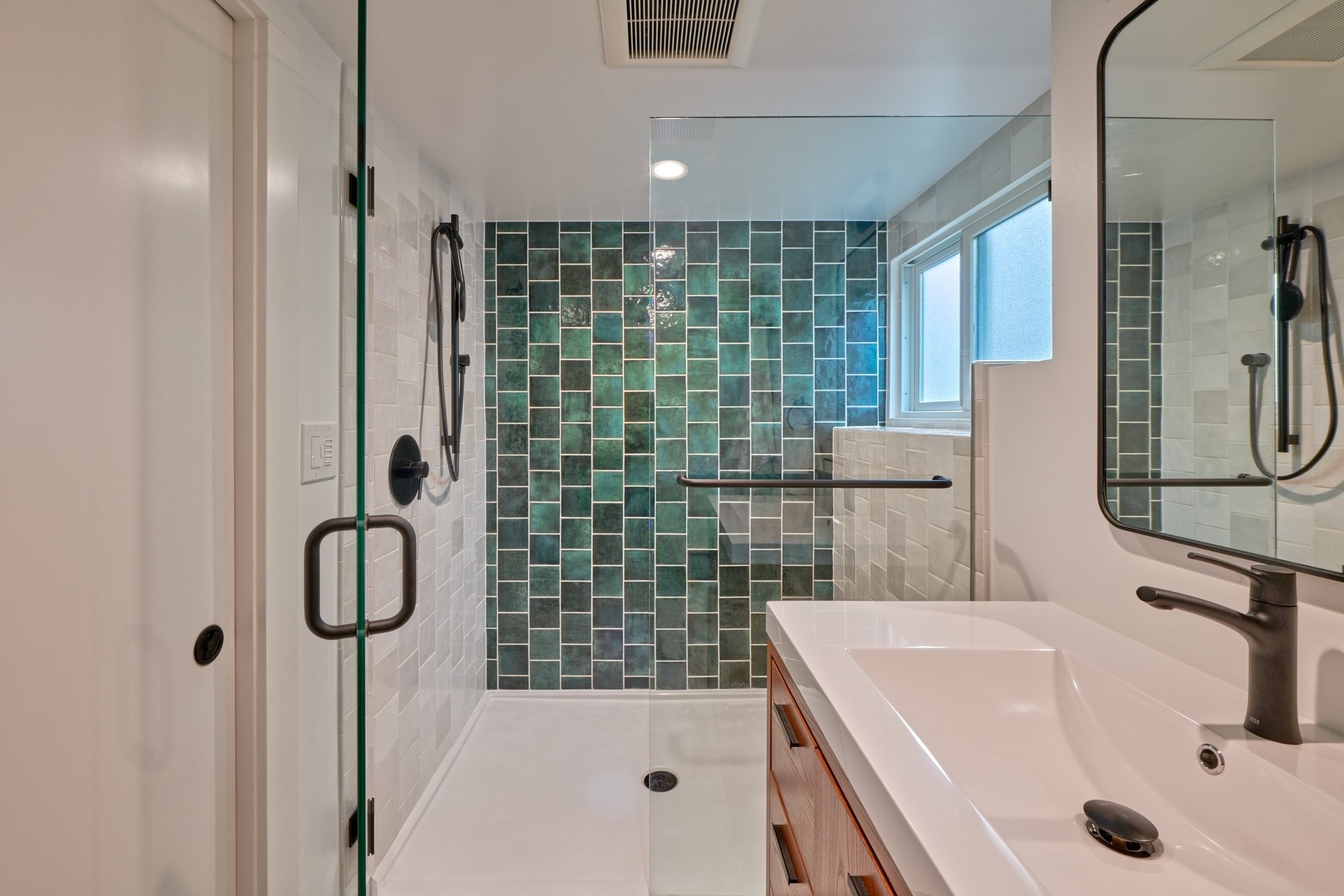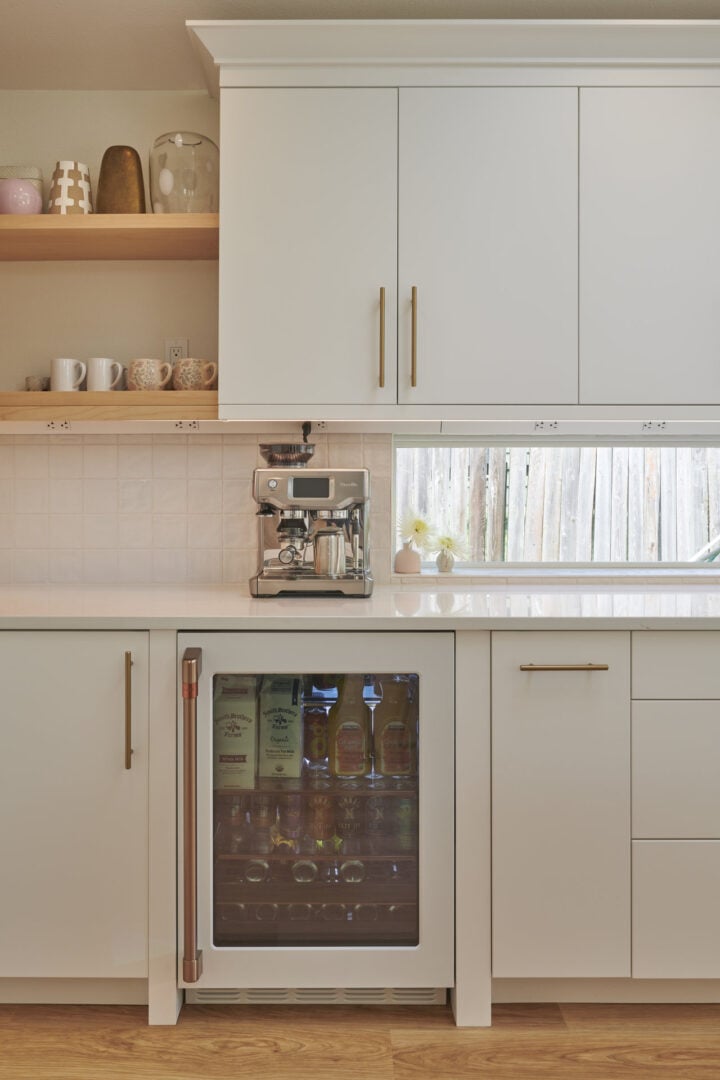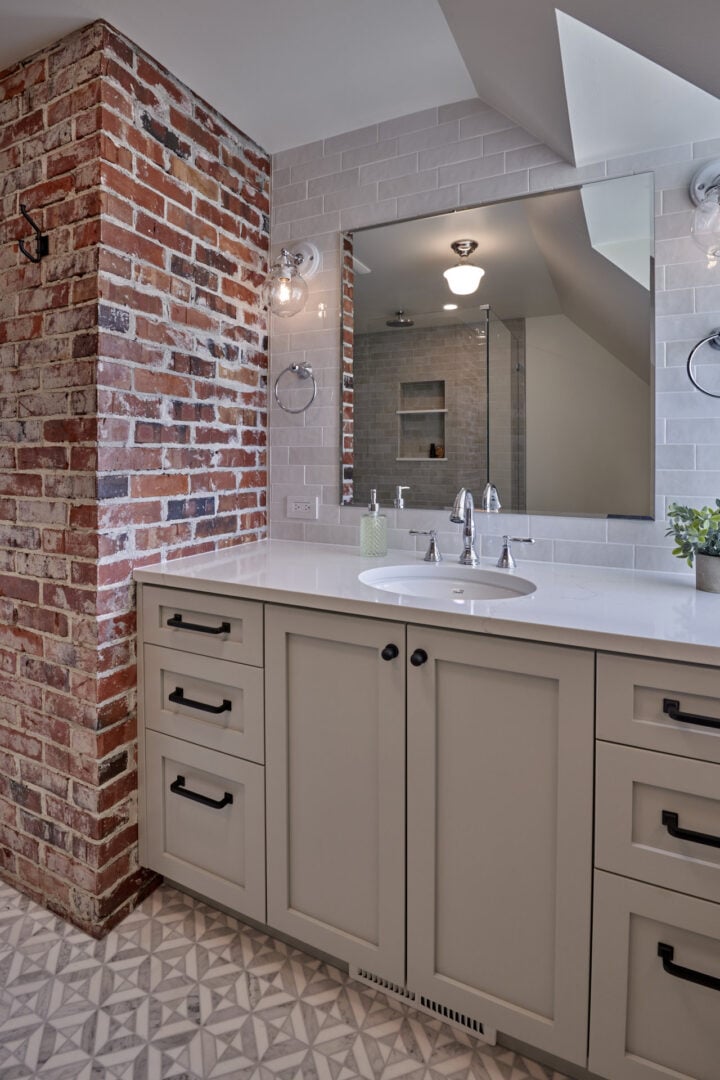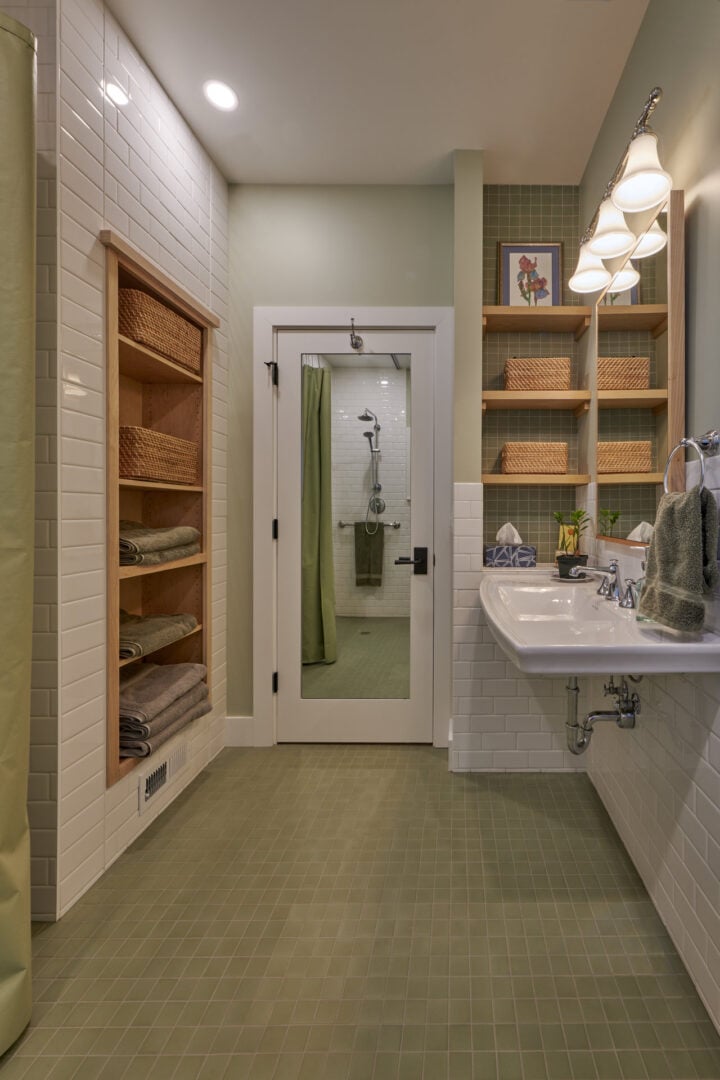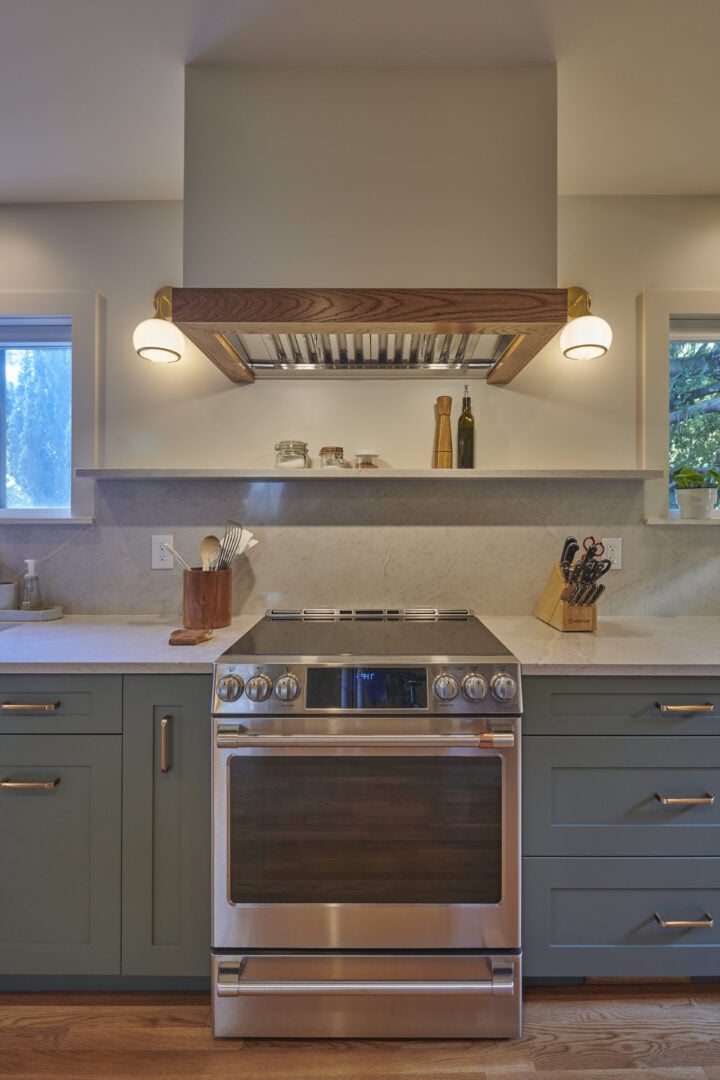
It’s essential to have the right storage solutions in your home—not only to make your space more organized but also to simplify your day-to-day life. One of the best ways to do this is by incorporating a lazy Susan cabinet into your kitchen or pantry.
Whether you have a new home or are looking to redo your storage spaces, lazy Susans are an excellent option to maximize storage and accessibility, particularly in those hard-to-reach corners. Lazy Susans were popularized in the early 1900s. Let’s dig into the history of this cabinet style, its advantages, plus our team’s best recommendations for materials.
Introduction to Kitchen Storage Solutions
Maximizing every inch of your kitchen is key to creating a space that’s both beautiful and functional. That’s where smart storage solutions come in—especially when it comes to those tricky corner spaces. A corner cabinet is a great way to make use of areas that might otherwise go to waste. With a lazy susan base cabinet, you can put all your stored items within reach, eliminating the need to hunt around deep into the back of your cupboards.
They come in a variety of styles and designs, so you can find the perfect fit for your kitchen—whether your taste leans traditional or modern.
The Ultimate Guide to Lazy Susan Cabinets: Types, Benefits and Tips
What is a lazy Susan cabinet?
The concept entails rotating racks mounted on a turntable base. The spinning system works inside a cabinet, on a table, or on a countertop. The mechanism uses bearings that make the whole device rotate, usually 360 degrees, similar to a turntable. It’s anchored by mounts or posts that hold it in a fixed position while it turns.
You will often find them in corner cupboards, as the turntable makes it easy to reach everything hidden deep inside those corners. They are commonly installed in lower corner base cabinets but can also be used in wall cabinets or pantries.
Where Did the Name Come From?
The origins of the term “lazy Susan” remain a mystery. Some speculation says President Thomas Jefferson had the first lazy Susan developed for his daughter—who always complained about being the last to eat at the table—while others say it was Thomas Edison who developed the concept. The rest chalk it up to a generic name that caught on, much like “Peeping Tom.” Lazy Susans are a staple in traditional and vintage kitchen designs.
Regardless of which Thomas or Susan we have to thank for the invention, they are great, and we will explain all the advantages of having one—especially as a corner cabinet.
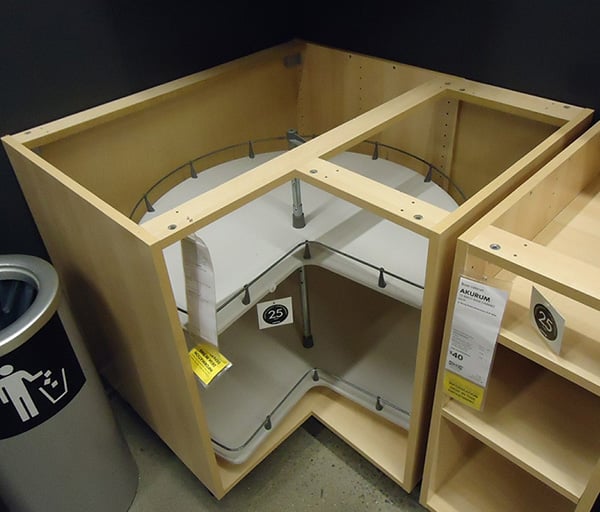
Source: commons.wikimedia.org
Advantages
1. Solves the Problem of Blind Corners
Blind corner cabinets are usually huge and often not user-friendly. It’s almost impossible to get anything in or out of them, not to mention to try to organize what’s inside.
That is, until you get a lazy Susan, which eliminates this issue by making every inch of your cabinet usable and easily accessible! Because the spinning mechanism allows you to reach everything stored deep inside the cabinet without hassle, you won’t have any trouble grabbing what you need.
2. Makes It Easier to Find Items
You might be familiar with the frustration of trying to locate one particular ingredient for your recipe and digging through loose spices and condiments just to find it. In most cases, you will find your elusive ingredient hidden in the innermost corner of the cabinet, by which time you’re probably entirely irritated.
A lazy Susan means you’ll never have to deal with this. The rotation mechanism will bring the items at the back of the cabinet toward the front for easy reach, saving you time and frustration.
It also allows you to organize your cabinet space without having to make a mess every time you need something.
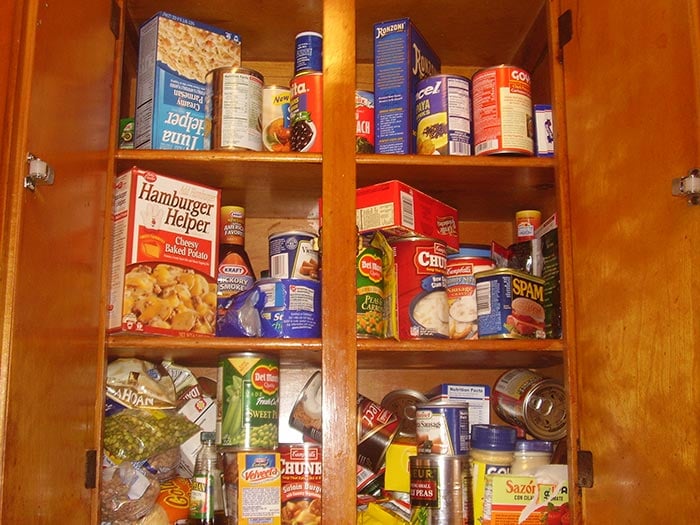
Source: commons.wikimedia.org
3. Reduces Clutter and Maximizes Space
With standard shelving, it’s easy for the clutter to get out of hand. A lazy Susan will help declutter, so you can keep everything neat and tidy. The multi-tiered system maximizes vertical storage space, meaning that you can store more in your cabinets while also keeping everything organized. Additionally, most cabinets can fit two or more rotating shelf tiers, meaning they can fit more items than would have been possible in an ordinary cupboard.
The Most Common Types of Lazy Susans
1. Full-Circle Lazy Susan Cabinet
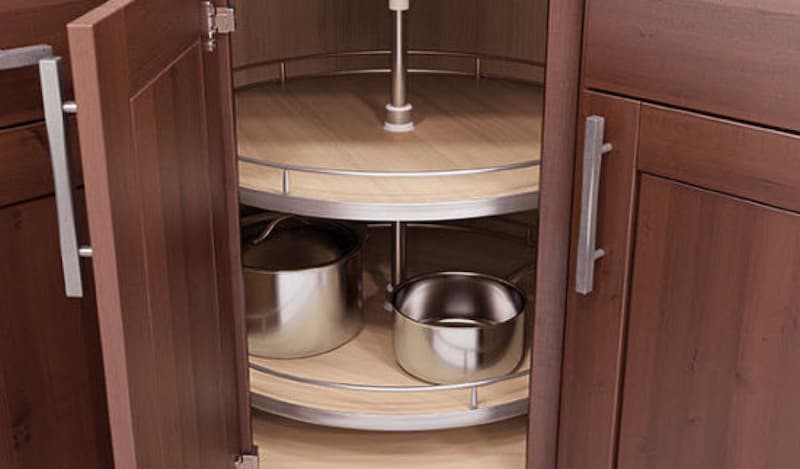
Source: Pinterest
This is the most common type and rotates 360 degrees, allowing for more storage space. You can also move the racks up and down to accommodate several tiers in a single cabinet. A “Super” Lazy Susan cabinet features independently rotating shelving.
The full circle can be used in base cabinets or to increase storage and functionality on the kitchen counter. It works for most cupboards, including corner cabinets with doors that open at a 45-degree angle.
2. Kidney-Shaped Lazy Susan Cabinet
As the name suggests, this shape looks a lot like a kidney. It has a triangular cut-out end, so a cabinet door that closes at a 90-degree angle can open and shut smoothly.
Note: The kidney-shape design is best suited for L-shaped corner cabinets in the kitchen.
3. D-Shaped Lazy Susan Cabinet
The D-shaped design resembles the letter D. It has one rounded side while being flat on the other end, making it perfect for a pantry cabinet. The flat back allows the cabinet door to close seamlessly while still offering generous storage capacity.
What Materials Are Used?
A great kitchen balances both aesthetic and function. To achieve both, the materials and finishes you use for your cabinets should blend perfectly.
With this in mind, there are several different materials you can opt for:
Wood: A classic option that adds warmth to your cabinetry
Plastic: Durable and affordable for everyday use
Metal: Sleek and modern, perfect for a more minimalist aesthetic
Glass or Marble: Either one adds a touch of luxury to your storage, but will need special care
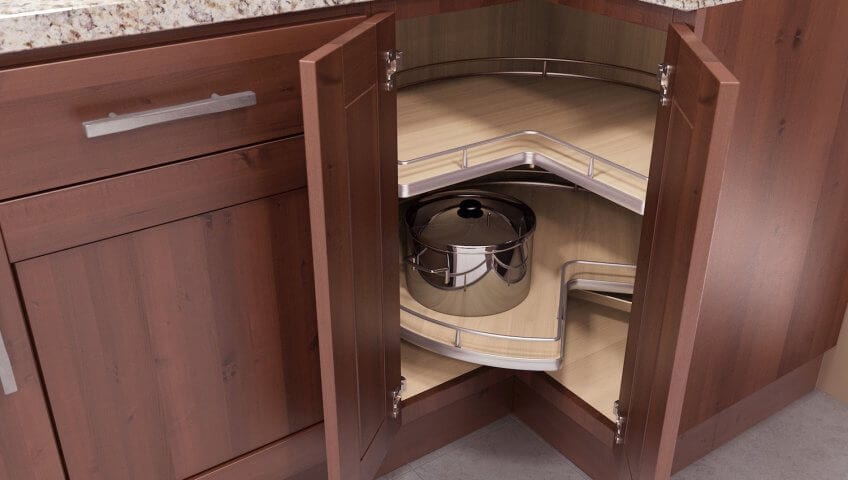
Source: Vauth Segal
Another important consideration is the color. Using a color similar to the one on your kitchen cabinet helps improve your home’s overall look.
The cabinet door that your lazy Susan is behind will usually be made to match the rest of your cabinetry.
Organizers
To make the most out of your lazy Susan–optimized kitchen cupboards, use organizers to subdivide the shelves.
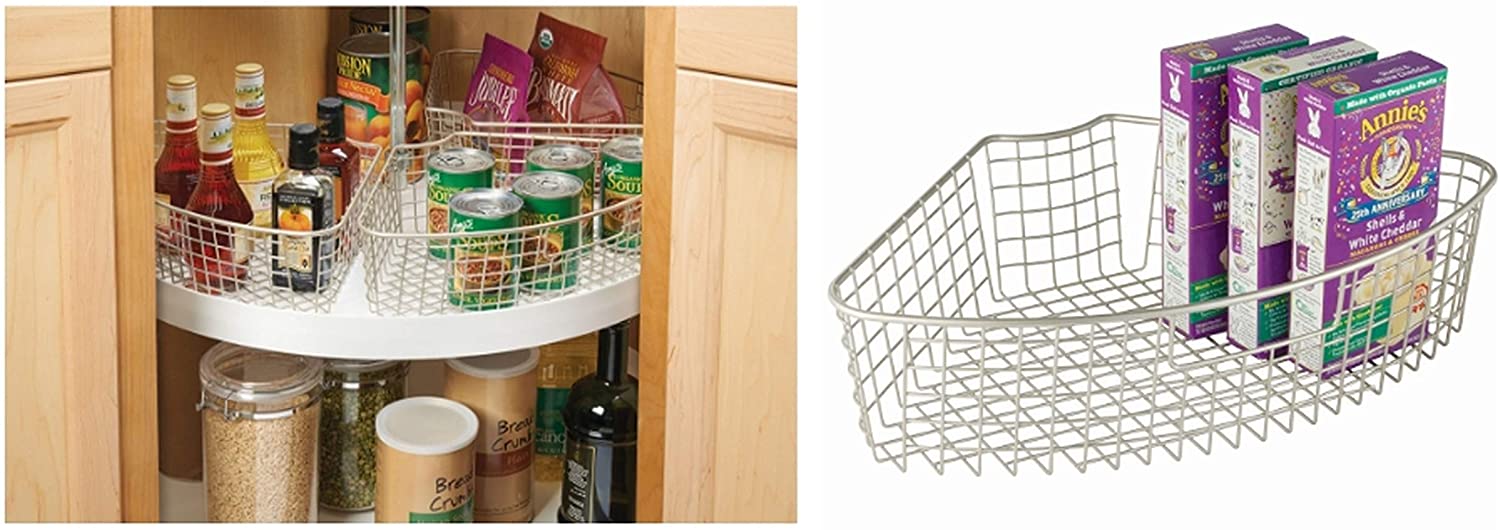
Source: Amazon
Organizers come in different brands and materials. Store-bought organizing bins usually come in plastic, wire, or wood.
How to Size a Custom Lazy Susan Cabinet
Measure the inner width and depth of your cabinet.
Subtract up to 4 inches from your width measurements to get the exact diameter of your lazy Susan.
- Measure the cabinet’s height to see how many tiers can fit inside.
Note: The shelf must be far enough from the cabinet walls to ensure a smooth rotation.
You have to get the measurements right, or you’ll get a non-functional turntable that either wobbles or doesn’t rotate.
Design and Installation Considerations
Designing and installing a lazy Susan cabinet requires careful planning. Start by measuring your available area to determine the right size and style of cabinet for your needs. Think about the type of storage units you want—these can vary from wooden ones to sleek metal or glass options, each offering a unique look and feel.
The choice of material and finish for your cabinet is important, as it should complement the rest of your kitchen. Whether you prefer a painted, stained, or natural finish, there’s a variety of options to suit your style. The mechanism inside your cabinet can also vary, depending on the design you select, and will impact how smoothly your turntable operates.
For the best results, consider working with a professional designer or contractor who can help you navigate these choices and ensure a flawless installation. By taking the time to review your options and plan carefully, you’ll end up with a setup that’s both functional and stylish, perfectly tailored to your kitchen.
Integration with Existing Cabinets
Blending a new lazy susan with your existing cabinetry is a great way to update your kitchen’s look and boost its functionality. To achieve a seamless integration, pay close attention to the style, material, and finish of your current cabinets.
It’s also important to think about the contents you plan to store. Consider what items you’ll need quick access to and how often you’ll use them, so you can organize your storage space efficiently. By thoughtfully integrating a lazy susan, you’ll enjoy a more organized kitchen with easy access to everything you need.
Tips for Cleaning and Maintaining Your Lazy Susan
Taking care of your Lazy Susan cabinets will help prevent damage and extend their lifespan. With the right care, your cupboards can last a lifetime. Here’s how to keep them in top shape:
Use a soft cloth and a mild cleaning agent, such as dish soap, to clean the shelves.
Vacuum inside to remove dirt in the corners and under the turntables.
Avoid harsh chemicals like ammonia and bleach that can damage the shelf.
Avoid using too much water, as that can damage the mechanical system and wood.
Use plastic spatulas if you have to scrape off debris so that you won’t scratch the surfaces.
Creative Uses for Lazy Susans Around the Home
While lower shelves in the kitchen are the most common place to find lazy Susans, there are so many other spots around the house where they can be beneficial.
Check out this video to learn more:
Lazy Susans aren’t just for kitchen cabinets! Here are some other ways to use them throughout your home to incorporate more clever storage:
In the pantry: Organize cans, jars and bottles so nothing gets forgotten
Under the sink: This is a great way to store cleaning supplies
On the dinner table: Keep condiments and dishes within easy reach for your family and guests
In the bathroom: Use a lazy Susan to organize skincare, cosmetics and toiletries
As a spice rack: The perfect way to keep your spices tidy, visible and easy to grab
In the fridge: Prevent spills and group-like items while also making the most of limited refrigerator space
Why Lazy Susans Are a Must-Have for Every Home
Lazy Susans are more than just a convenience—they help to transform even the smallest space. By improving storage, accessibility and organization, this clever solution will help you make the most of your space. All while helping to keep your home tidy!
Ready to add a lazy Susan to your cabinets? At CRD Design Build, we specialize in creating custom storage solutions that fit your needs perfectly.

